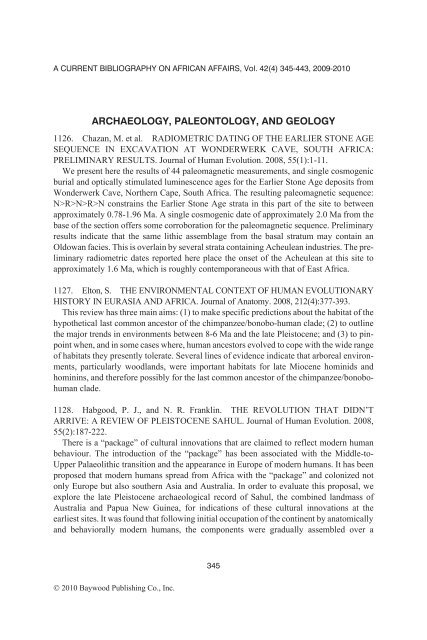A Current Bibliography on African Affairs - Baywood Publishing
A Current Bibliography on African Affairs - Baywood Publishing
A Current Bibliography on African Affairs - Baywood Publishing
Create successful ePaper yourself
Turn your PDF publications into a flip-book with our unique Google optimized e-Paper software.
A CURRENT BIBLIOGRAPHY ON AFRICAN AFFAIRS, Vol. 42(4) 345-443, 2009-2010<br />
ARCHAEOLOGY, PALEONTOLOGY, AND GEOLOGY<br />
1126. Chazan, M. et al. RADIOMETRIC DATING OF THE EARLIER STONE AGE<br />
SEQUENCE IN EXCAVATION AT WONDERWERK CAVE, SOUTH AFRICA:<br />
PRELIMINARY RESULTS. Journal of Human Evoluti<strong>on</strong>. 2008, 55(1):1-11.<br />
We present here the results of 44 paleomagnetic measurements, and single cosmogenic<br />
burial and optically stimulated luminescence ages for the Earlier St<strong>on</strong>e Age deposits from<br />
W<strong>on</strong>derwerk Cave, Northern Cape, South Africa. The resulting paleomagnetic sequence:<br />
N>R>N>R>N c<strong>on</strong>strains the Earlier St<strong>on</strong>e Age strata in this part of the site to between<br />
approximately 0.78-1.96 Ma. A single cosmogenic date of approximately 2.0 Ma from the<br />
base of the secti<strong>on</strong> offers some corroborati<strong>on</strong> for the paleomagnetic sequence. Preliminary<br />
results indicate that the same lithic assemblage from the basal stratum may c<strong>on</strong>tain an<br />
Oldowan facies. This is overlain by several strata c<strong>on</strong>taining Acheulean industries. The preliminary<br />
radiometric dates reported here place the <strong>on</strong>set of the Acheulean at this site to<br />
approximately 1.6 Ma, which is roughly c<strong>on</strong>temporaneous with that of East Africa.<br />
1127. Elt<strong>on</strong>, S. THE ENVIRONMENTAL CONTEXT OF HUMAN EVOLUTIONARY<br />
HISTORY IN EURASIA AND AFRICA. Journal of Anatomy. 2008, 212(4):377-393.<br />
This review has three main aims: (1) to make specific predicti<strong>on</strong>s about the habitat of the<br />
hypothetical last comm<strong>on</strong> ancestor of the chimpanzee/b<strong>on</strong>obo-human clade; (2) to outline<br />
the major trends in envir<strong>on</strong>ments between 8-6 Ma and the late Pleistocene; and (3) to pinpoint<br />
when, and in some cases where, human ancestors evolved to cope with the wide range<br />
of habitats they presently tolerate. Several lines of evidence indicate that arboreal envir<strong>on</strong>ments,<br />
particularly woodlands, were important habitats for late Miocene hominids and<br />
hominins, and therefore possibly for the last comm<strong>on</strong> ancestor of the chimpanzee/b<strong>on</strong>obohuman<br />
clade.<br />
1128. Habgood, P. J., and N. R. Franklin. THE REVOLUTION THAT DIDN’T<br />
ARRIVE: A REVIEW OF PLEISTOCENE SAHUL. Journal of Human Evoluti<strong>on</strong>. 2008,<br />
55(2):187-222.<br />
There is a “package” of cultural innovati<strong>on</strong>s that are claimed to reflect modern human<br />
behaviour. The introducti<strong>on</strong> of the “package” has been associated with the Middle-to-<br />
Upper Palaeolithic transiti<strong>on</strong> and the appearance in Europe of modern humans. It has been<br />
proposed that modern humans spread from Africa with the “package” and col<strong>on</strong>ized not<br />
<strong>on</strong>ly Europe but also southern Asia and Australia. In order to evaluate this proposal, we<br />
explore the late Pleistocene archaeological record of Sahul, the combined landmass of<br />
Australia and Papua New Guinea, for indicati<strong>on</strong>s of these cultural innovati<strong>on</strong>s at the<br />
earliest sites. It was found that following initial occupati<strong>on</strong> of the c<strong>on</strong>tinent by anatomically<br />
and behaviorally modern humans, the comp<strong>on</strong>ents were gradually assembled over a<br />
2010 <strong>Baywood</strong> <strong>Publishing</strong> Co., Inc.<br />
345




